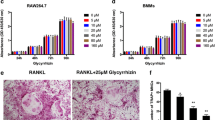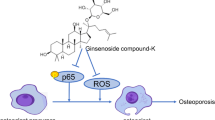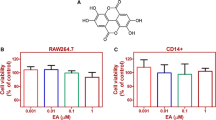Abstract
Nuclear factor-erythroid 2-related factor 2 (Nrf2) is a redox-sensitive transcription factor, which plays an important role in the cellular defense against oxidative stress by induction of anti-oxidant and cytoprotective enzymes. In the current study, we sought to investigate the osteoprotective effect of carnosic acid (CA), a phenolic (catecholic) diterpene. It is widely identified for its electrophilic nature under oxidative stress conditions and thus anticipated to counter osteoporosis by facilitation of Nrf2 signalling. Osteoclast differentiation was induced by incubation of RAW 264.7 (mouse macrophage) cells and mouse bone marrow macrophages (BMMs) in the presence of receptor activator of NF-κB ligand (RANKL) (100 ng/ml). After treatment, osteoclastogenesis was assessed using tartrate-resistant acid phosphatase (TRAP) assay. We observed that 6 h pretreatment with CA (1.25, 2.5, 5 μM) decreased RANKL-induced osteoclast formation and abolished RANKL-induced ROS generation by activating Nrf2 and its transcriptional targets. Further, CA also inhibited RANKL-induced activation of NF-κB and MAPK signalling. RANKL-induced mRNA expression of osteoclast related genes and transcription factors was also diminished by CA. In vivo osteolysis was developed in C57BL/6 male mice using lipopolysaccharide (LPS). Consistent with in vitro results, in vivo μ-CT analysis of femurs showed that bone mineral density (BMD), bone mineral content (BMC), and bone architecture parameters such as trabecular thickness (Tb.Th) and trabecular space (Tb.Sp) were positively modulated by CA in LPS-injected mice. The results obtained in this study support that CA inhibits RANKL-induced osteoclastogenesis by maintaining redox homeostasis through modulation of Nrf2 and NF-κB pathways.
Key Messages
-
Carnosic acid (CA) inhibits RANKL-induced osteoclastogenesis.
-
CA inhibits RANKL-induced oxidative stress by upregulating Nrf2 transcriptional targets.
-
CA attenuates RANKL-induced NF-κB and MAPK signalling activation.
-
CA decreases NFATc1 and c-Fos expression.
-
In vivo μ-CT analysis reveals that CA prevents bone loss in LPS-injected mice.








Similar content being viewed by others
References
Zheng M, Phan T, Xu J (2004) Interaction between osteoblast and osteoclast: impact in bone disease. Histol Histopathol 19:1325–1344
Boyle WJ, Simonet WS, Lacey DL (2003) Osteoclast differentiation and activation. Nature 423:337–342
Takayanagi H (2005) Mechanistic insight into osteoclast differentiation in osteoimmunology. J Mol Med (Berl) 83:170–179
Asagiri M, Takayanagi H (2007) The molecular understanding of osteoclast differentiation. Bone 40:251–264
Lee J-H, Jin H, Shim H-E, Kim H-N, Ha H, Lee ZH (2010) Epigallocatechin-3-gallate inhibits osteoclastogenesis by down-regulating c-Fos expression and suppressing the nuclear factor-κB signal. Mol Pharmacol 77:17–25
Dannemann C, Grätz K, Riener M, Zwahlen R (2007) Jaw osteonecrosis related to bisphosphonate therapy: a severe secondary disorder. Bone 40:828–834
Perazella MA, Markowitz GS (2008) Bisphosphonate nephrotoxicity. Kidney Int 74:1385–1393
Morley P, Whitfield JF, Willick GE (2001) Parathyroid hormone: an anabolic treatment for osteoporosis. Curr Pharm des 7:671–687
Kaspar JW, Niture SK, Jaiswal AK (2009) Nrf2: INrf2 (Keap1) signaling in oxidative stress. Free Radic Biol Med 47:1304–1309
Lee NK, Choi YG, Baik JY, Han SY, Jeong D-W, Bae YS, Kim N, Lee SY (2005) A crucial role for reactive oxygen species in RANKL-induced osteoclast differentiation. Blood 106:852–859
Thummuri D, Jeengar MK, Shrivastava S, Nemani H, Ramavat RN, Chaudhari P, Naidu V (2015) Thymoquinone prevents RANKL-induced osteoclastogenesis activation and osteolysis in an in vivo model of inflammation by suppressing NF-KB and MAPK Signalling. Pharmacol res 99:63–73
Satoh T, McKercher SR, Lipton SA (2014) Nrf2/ARE-mediated antioxidant actions of pro-electrophilic drugs. Free Radic Biol Med 66:45–57
Kar S, Palit S, Ball WB, Das PK (2012) Carnosic acid modulates Akt/IKK/NF-κB signaling by PP2A and induces intrinsic and extrinsic pathway mediated apoptosis in human prostate carcinoma PC-3 cells. Apoptosis 17:735–747
de La Roche M, Rutherford TJ, Gupta D, Veprintsev DB, Saxty B, Freund SM, Bienz M (2012) An intrinsically labile α-helix abutting the BCL9-binding site of β-catenin is required for its inhibition by carnosic acid. Nat Commun 3:680
Jordán MJ, Lax V, Rota MC, Lorán S, Sotomayor JA (2012) Relevance of carnosic acid, carnosol, and rosmarinic acid concentrations in the in vitro antioxidant and antimicrobial activities of Rosmarinus officinalis (L.) methanolic extracts. J Agric Food Chem 60:9603–9608
Ojeda-Sana AM, Repetto V, Moreno S (2013) Carnosic acid is an efflux pumps modulator by dissipation of the membrane potential in Enterococcus faecalis and Staphylococcus aureus. World J Microbiol Biotechnol 29:137–144
Hadad N, Levy R (2012) The synergistic anti-inflammatory effects of lycopene, lutein, β-carotene, and carnosic acid combinations via redox-based inhibition of NF-κB signaling. Free Radic Biol Med 53:1381–1391
Oh J, Yu T, Choi SJ, Yang Y, Baek HS, An S, Kwon LK, Kim J, Rho HS, Shin SS (2012) Syk/Src pathway-targeted inhibition of skin inflammatory responses by carnosic acid. Mediators Inflamm 2012
Wang QL, Li H, Li XX, Cui CY, Wang R, Yu NX, Chen LX (2012) Acute and 30-day oral toxicity studies of administered carnosic acid. Food Chem Toxicol 50:4348–4355
Satoh T, Kosaka K, Itoh K, Kobayashi A, Yamamoto M, Shimojo Y, Kitajima C, Cui J, Kamins J, Okamoto S (2008) Carnosic acid, a catechol-type electrophilic compound, protects neurons both in vitro and in vivo through activation of the Keap1/Nrf2 pathway via S-alkylation of targeted cysteines on Keap1. J Neurochem 104:1116–1131
Miller DM, Singh IN, Wang JA, Hall ED (2013) Administration of the Nrf2–ARE activators sulforaphane and carnosic acid attenuates 4-hydroxy-2-nonenal-induced mitochondrial dysfunction ex vivo. Free Radic Biol Med 57:1–9
Thummuri D, Jeengar MK, Shrivastava S, Areti A, Yerra VG, Yamjala S, Komirishetty P, Naidu V, Kumar A, Sistla R (2014) Boswellia ovalifoliolata abrogates ROS mediated NF-κB activation, causes apoptosis and chemosensitization in triple negative breast cancer cells. Environ Toxicol Pharmacol 38:58–70
Teitelbaum SL (2000) Bone resorption by osteoclasts. Science 289:1504–1508
Hanada R, Hanada T, Sigl V, Schramek D, Penninger JM (2011) RANKL/RANK-beyond bones. J Mol Med (Berl) 89:647–656
Hyeon S, Lee H, Yang Y, Jeong W (2013) Nrf2 deficiency induces oxidative stress and promotes RANKL-induced osteoclast differentiation. Free Radic Biol Med 65:789–799
Kanzaki H, Shinohara F, Kajiya M, Fukaya S, Miyamoto Y, Nakamura Y (2014) Nuclear Nrf2 induction by protein transduction attenuates osteoclastogenesis. Free Radic Biol Med 77:239–248
Kensler TW, Wakabayashi N, Biswal S (2007) Cell survival responses to environmental stresses via the Keap1-Nrf2-ARE pathway. Annu rev Pharmacol Toxicol 47:89–116
Kosaka K, Mimura J, Itoh K, Satoh T, Shimojo Y, Kitajima C, Maruyama A, Yamamoto M, Shirasawa T (2010) Role of Nrf2 and p62/ZIP in the neurite outgrowth by carnosic acid in PC12h cells. J Biochem 147:73–81
Karin M (2005) Inflammation-activated protein kinases as targets for drug development. Proc Am Thorac Soc 2:386–390
Matsumoto M, Sudo T, Saito T, Osada H, Tsujimoto M (2000) Involvement of p38 mitogen-activated protein kinase signaling pathway in osteoclastogenesis mediated by receptor activator of NF-κB ligand (RANKL). J Biol Chem 275:31155–31161
Sasaki CY, Barberi TJ, Ghosh P, Longo DL (2005) Phosphorylation of RelA/p65 on serine 536 defines an IκBα-independent NF-κB pathway. J Biol Chem 280:34538–34547
Tanaka S, Miyazaki T, Fukuda A, Akiyama T, Kadono Y, Wakeyama H, Kono S, Hoshikawa S, Nakamura M, Ohshima Y (2006) Molecular mechanism of the life and death of the osteoclast. Ann N Y Acad Sci 1068:180–186
Barrow AD, Raynal N, Andersen TL, Slatter DA, Bihan D, Pugh N, Cella M, Kim T, Rho J, Negishi-Koga T (2011) OSCAR is a collagen receptor that costimulates osteoclastogenesis in DAP12-deficient humans and mice. J Clin Invest 121:3505–3516
Ishida-Kitagawa N, Tanaka K, Bao X, Kimura T, Miura T, Kitaoka Y, Hayashi K, Sato M, Maruoka M, Ogawa T (2012) Siglec-15 protein regulates formation of functional osteoclasts in concert with DNAX-activating protein of 12 kDa (DAP12). J Biol Chem 287: 17493–17502
Koga T, Inui M, Inoue K, Kim S, Suematsu A, Kobayashi E, Iwata T, Ohnishi H, Matozaki T, Kodama T (2004) Costimulatory signals mediated by the ITAM motif cooperate with RANKL for bone homeostasis. Nature 428:758–763
Arthur J, Qiao J, Shen Y, Davis A, Dunne E, Berndt M, Gardiner E, Andrews R (2012) ITAM receptor-mediated generation of reactive oxygen species in human platelets occurs via Syk-dependent and Syk-independent pathways. J Thromb Haemost 10:1133–1141
Teitelbaum SL (2004) RANKing c-Jun in osteoclast development. J Clin Invest 114:463–465
Wang Z-Q, Ovitt C, Grigoriadis AE, Möhle-Steinlein U, Rüther U, Wagner EF (1992) Bone and haematopoietic defects in mice lacking c-fos. Nature 360:741–745
Takayanagi H, Kim S, Koga T, Nishina H, Isshiki M, Yoshida H, Saiura A, Isobe M, Yokochi T, Inoue J-I (2002) Induction and activation of the transcription factor NFATc1 (NFAT2) integrate RANKL signaling in terminal differentiation of osteoclasts. Dev Cell 3:889–901
Huang Q-Q, Pope RM (2009) The role of toll-like receptors in rheumatoid arthritis. Curr Rheumatol Rep 11:357–364
Acknowledgements
Financial support from DBT (Sanction order number: BT/SBIRI-1188/SBIRI-23/13) and Department of Pharmaceuticals, Ministry of Chemicals and Fertilizers, Government of India is acknowledged.
Author information
Authors and Affiliations
Corresponding author
Ethics declarations
Conflict of interest
The authors declare that they have no conflict of interest.
Electronic supplementary material
ESM 1
(PDF 239 kb)
Rights and permissions
About this article
Cite this article
Thummuri, D., Naidu, V.G.M. & Chaudhari, P. Carnosic acid attenuates RANKL-induced oxidative stress and osteoclastogenesis via induction of Nrf2 and suppression of NF-κB and MAPK signalling. J Mol Med 95, 1065–1076 (2017). https://doi.org/10.1007/s00109-017-1553-1
Received:
Revised:
Accepted:
Published:
Issue Date:
DOI: https://doi.org/10.1007/s00109-017-1553-1




